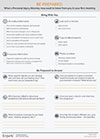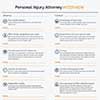If you were injured from a defective product, you should know what to do and what your options could be.
We’re surrounded by the products we buy... all day, every day.
Whether it’s our cars, clothes, appliances and electronics, toys or baby equipment, or any other manufactured item that we interact with in our daily lives, we use them with the expectation that they won’t cause us injury or harm.
But sometimes they do.
Here’s a look at District of Columbia product liability claims—the area of law that allows personal injury lawsuits when you’re injured by a product defect—for what you can recover, how much, when, and how to recover compensation.
Types of product defects
There are three ways a company could be liable for a product defect:
Manufacturing defect
This happens in the process of producing the item. It could be because of negligent workmanship or substandard materials used to build or assemble the final product. It could affect all products in a batch, such as in an assembly line malfunction. It could also affect an individual item, if something went wrong in manufacturing that wasn’t caught on a quality assurance check.
Design defect
When there’s a design defect, the product is inherently flawed. No matter how well the product was manufactured according to its specifications—with no mistakes—it’s still unsafe because it its design fails to meet basic safety standards.
Failure to warn
These products could be well-designed and correctly manufactured but carry inherent risks. When this happens, the manufacturer is responsible for providing adequate warnings to the consumer or the public so that they know how to use the product safely.
You’ve probably seen an appliance like a hair dryer that has a large tag on the electrical cord that warns the user of electric shock if the appliance is dropped or used in water. If the manufacturer does not include this warning and if a user is injured because they did not know that the hair dryer couldn’t be used in the bathtub, then the manufacturer could be liable for a failure to warn.
Another example is over-the-counter drugs. Some cold medicines and decongestants can make you drowsy or less alert; their package inserts are required to include a warning that it could be dangerous to drive a car or operate heavy machinery while taking the drug.
Types of product liability claims
If you’ve been injured by a product because of a manufacturing or design defect or failure to warn, you might be interested in making a claim for liability in order to be compensated for your losses.
Most product liability claims fall into one of these three categories:
Negligence
Negligence is the general standard for a personal injury lawsuit. There are five elements necessary for a finding of negligence:
- Duty. A manufacturer, retailer, or distributor owes a duty of care to a consumer or recipient of goods that the goods will meet certain safety standards and not cause injury when used correctly.
- Breach. This happens when the person responsible for upholding a duty of care fails to do so and acts in a way that could be reasonably foreseen to cause an injury.
- Causation. In order to file a lawsuit, the breach needs to be the actual cause of the injury. It’s not enough for the product to be defective—the defect needs to have caused an injury to the plaintiff.
- Injury. You could receive a defective product and being stuck with paying for something that doesn’t work properly or that you can’t return is definitely an annoyance. We’ve all been there. But you can’t file a product liability claim for annoyance, unfortunately. There might be recourse through consumer protection avenues, but not as a negligence claim. “Injury” in the legal sense refers to an actual injury. Inconvenience is not an injury.
- Damages. The injury has to cost you money for medical treatment or other expenses. For instance, say you sat on a chair that had a defective leg and it toppled, causing you to fall. You might fall on the floor and get an uncomfortable bruise, but if it didn’t require medical treatment (other than grabbing yourself an ice pack from the freezer), you can’t file a claim for negligence because it didn’t cost you money.
Strict liability
A strict liability claim shifts the focus from the injury, itself, to the manufacturer and the process. Strict liability exists when the defendant is liable for the injury, regardless of whether they were negligent.
Strict liability is liability without fault.
The plaintiff or claimant only needs to prove that the injury happened and the defendant was responsible. However, some defendants can defend against a strict liability lawsuit by claiming that the product was misused.
Breach of warranty
There are two types of warranties: express and implied.
| Express warranty | Implied warranty |
|---|---|
| Guarantee that a product will meet a certain level of quality and reliability. If the product fails, the manufacturer will repair or replace the product or its relevant parts. | The product is guaranteed to work as intended. It conforms to the standards expected for the specific product, and it would work appropriately for the intended use by the manufacturer. |
Washington, DC, Consumer Protection Law
It’s noteworthy that the Department of Consumer and Regulatory Affairs and the Office of Consumer and Trade Protection section of the Office of the Attorney General enforce the DC Consumer Protection Procedures Act. This protects consumers from deceptive or unfair practices.
If you suffered an injury because of a defective product, you can file a lawsuit and recover damages that include:
| Punitive damages | This is based on the amount of fault by the manufacturer and the degree to which the manufacturer was aware of the product’s danger before it was released to the market or consumer. |
|---|---|
| Treble damages | This is $1,500 per violation or triple the amount of original damages you incurred, whichever is greater. |
| Attorney’s fees | Your attorney’s fees can be included as part of your damages in a product liability lawsuit. |
| Court injunction | The court has the authority to issue an injunction related to the lawsuit, which could include barring the manufacturer from selling the product until changes are made that would make it safer. |
| Other relief | The court could offer additional or alternative relief (aside from financial compensation) if it’s relevant and warranted in the specific case. |
Who can be held liable for a defective product?
Any company or person who handles an item before it reaches the consumer bears a duty of care. The defendant in a product liability claim could be any party in the product’s chain of distribution. Every product goes through a series of “hands” before it arrives at your home.
The manufacturer is only the first. These are some of the parties that could be defendants in a product liability claim:
- Manufacturers. The manufacturer seems like the obvious defendant in a product liability claim, but it’s not always so straightforward. A lot of products, especially appliances, contain components that are made by a variety of suppliers. If the defect is the result of a malfunction of one particular part of the item, the defendant could be the manufacturer of the part and not of the entire product. Normally, the manufacturer of the entire product (whoever’s name is on the box, usually) is also a defendant, but they could be joined by a secondary defendant.
- Wholesalers or distributors. Often, a manufacturer will send a product to a wholesaler or distributor for packaging, shipping, and other logistics. These logistics companies can also be liable for mistakes that happen when they’re in control of a product.
- Retailers. You can make a claim against any party in the chain of distribution, which could include the store where you bought the item.
Defenses to a product liability claim
The District of Columbia follows the pure contributory negligence standard of law. For most personal injury lawsuits, this means if the plaintiff had any responsibility for their own injury, they cannot recover damages.
In a product liability lawsuit, this benefits the defendant if they can demonstrate that:
- The plaintiff altered or modified the product from its original form
- The product was used contrary to included warnings or instructions
- The plaintiff knew there was a defect but used it anyway
- The plaintiff didn’t exercise reasonable care while using the product
In other words, these are some common defenses to a product liability lawsuit:
- Sealed container. This is the same as the “innocent seller” defense. If the seller received and sold the product in a sealed container and had no reason to believe the product was defective, the seller cannot be held liable.
- Product alteration. A third party altered the product in a way that wasn’t covered by the manufacturer’s instructions.
- Open and obvious risk. The risk was apparent, but the plaintiff made a choice to use the product in a specific way, regardless.
- Lack of safer alternatives. If the plaintiff’s claim is for defective design, the plaintiff must prove that there’s a safer alternative.
- No opportunity to warn. The plaintiff must prove that the defendant knew there was a risk and was unreasonable when they failed to warn of the danger.
- Contributory negligence. The plaintiff failed to use reasonable care.
Do you need a product liability lawyer?
If you were injured by a defective product and are considering a lawsuit, then yes. One reason is that as the consumer, you’re likely up against a large company with deep pockets and a robust team of lawyers who just want a claim or lawsuit to “go away.” They might offer you a lowball settlement, and depending on the severity of your injury, it might not be enough to cover your treatment and costs in their entirety.
If you purchased an item with the understanding that it would meet your needs and be safe when used properly, you’re entitled to compensation if it caused you injury.
A personal injury lawyer can help you determine the type of defect and lawsuit, how much you’re entitled to in compensation, and minimize your liability.
What does an injury lawyer do?
A personal injury lawyer helps individuals who have sustained injuries in accidents to recover financial compensation. These funds are often needed to pay for medical treatment, make up for lost wages and provide compensation for injuries suffered. Sometimes a case that seems simple at first may become more complicated. In these cases, consider hiring an experienced personal injury lawyer. Read more
Accident worksheets

A worksheet to prepare for your first meeting with a personal injury attorney – what to bring, what they'll ask
Download in PDF format

Checklist of 30 items to help you prepare for making a personal injury or accident claim
Download in PDF format

Worksheet with questions to ask a personal injury attorney to help determine if he or she will be a good fit for your case
Download in PDF format

Damages worksheet to track expenses for your injury claim (medical treatment, property damage, lost wages, prescriptions)
Download in PDF format

Sample accident journal/diary to help you document the effect on your daily life
Download in PDF format

Sample post-accident report form to keep in your glove box - fill out at the scene or as soon as you can after a car accident
Download in PDF format

